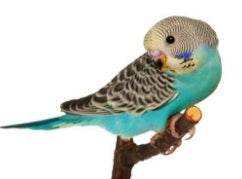
The Budgie is one of the most popular Parakeet species. Besides being very fun and playful, it is hardy, easy to care for, and one of the most affordable types of Parakeets.
This is a basic outline on how to care for your Parakeet. Further reading, either in books or online, is recommended for a complete guide.
History
Parakeets are originally from Australia, with Budgies being one of the more well known and popular types. The name “Budgie” actually comes from the word "budgerigar" -- from the Aboriginal Australians, who knew of the bird for over 40,000 years before Europeans arrived on the continent.
The first known writings on the Budgie come to us from John Gould, who in 1865, wrote about the bird in his book “Birds of Australia”. Following this, the Budgie, originally a nomadic flock bird, became incredibly popular in Europe, leading us to today where the Budgie can be found in houses all over the world.
Housing
Originating in Australia, Budgies are most comfortable in warm climates, ranging between 69 and 88 degrees Fahrenheit. You will want to put the birdcage off the ground and in an area that is well lit, we recommend placing it in the main living area next to a wall.
Your budgie’s cage should be a minimum of 16 x 16 x 16 for one bird, so as to provide enough space for the bird to move around freely (your bird will get bored if they can’t have fun!). You should also allow your Budgie to get used to their new surroundings as well. We recommend covering the cage in the early evening the first few days before trying to handle the bird.
Necessary Supplies
● Cage (minimum 16 x 16 x 16)
● Multiple Perches (rope, plastic, natural branch)
● Bird Food (treats, fruits, veggies)
● Toys (make sure to keep a rotation!)
● Cuttlebone or Mineral Block
Feeding
Variety is key to a healthy diet for your Budgie. An ideal diet for the bird includes a rotation of seeds and pellets, a large amount of carbohydrates (like whole wheat bread, cooked rice, and pasta), a fair amount of fresh fruits and vegetables, and just a bit of protein, like eggs and well-cooked meat.
It is also vital to provide fresh water and food every day -- Budgies can starve to death if not fed every 48 hours.
On the flip side, your Budgie is lactose intolerant so milk products should be limited to very small amounts of hard cheese and yogurt. You should avoid any processed foods or anything high in fat, salt, sugar or MSG, as well as any fruits with large seeds. And of course, it should go without saying that alcohol should be kept far away from your bird.
Health
Your bird’s health can be a very tricky thing as they’re designed to hide any signs of illness. Due to this, illness will often show itself in the Budgie’s behavior before any physical signs are discernible. Unwell birds may lose their desire to eat or drink, appear to be sleeping a lot, listless or lacking in energy.
Below we’ll give you a list of sure-fire signs that your bird is healthy and happy, but if your bird is missing more than a few of these, then it might be time to visit the vet.
● Your Budgie is active
● Your bird’s stool isn’t watery or sticking to the bird’s bottom
● Your bird’s beak and nails are not too long or too short
● Check the breastbone -- if you feel fat then your Budgie is overweight, but if the bone is very pronounced, your Budgie is underweight.
● Your bird’s breathing is normal -- if it is breathing heavily or there are audible clicks and squeaks, there may be a problem.
Do’s & Dont's
● Do play with your bird often
● Don’t touch or pet your bird too heavily, as they are very sensitive
● Do feed your bird a variety of healthy foods
● Don’t overfeed them, as Budgies may gain weight very easily
● Do give your birds lots of opportunities to rest so they remain friendly
● Don’t keep your bird in a cold or dark area, as they need heat and light

Fun Facts
● Budgies can register 150 images per second. Humans can only register 16.
● Budgies can count to three and rotate their heads 180 degrees.
● Budgies can store sound sequences in their head and have been known to learn approximately 100 words.
● Male parakeets are more likely than female parakeets to talk or whistle.
Questions?
The information provided here is meant to be a fun and insightful summary of the animal. By no means is it a comprehensive or exhaustive list and should not be treated as such. Always be sure to do your own research and consult experts such as veterinarians before making any decisions on your bird’s health.


